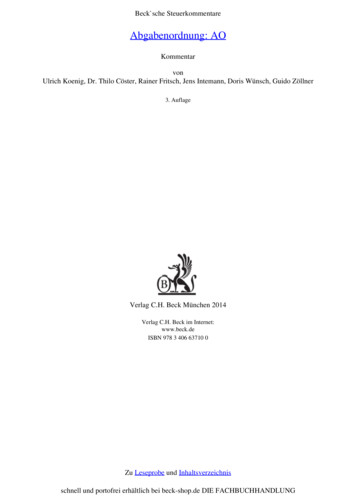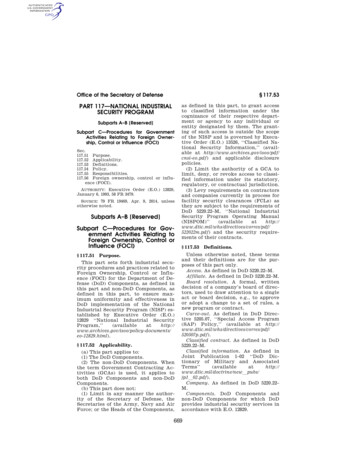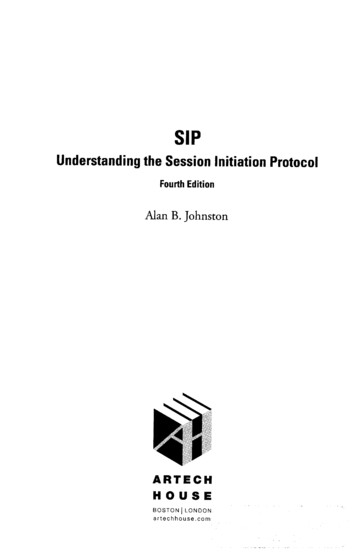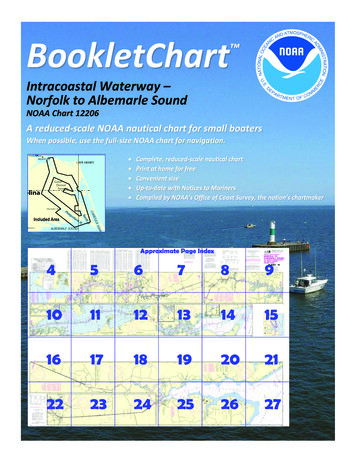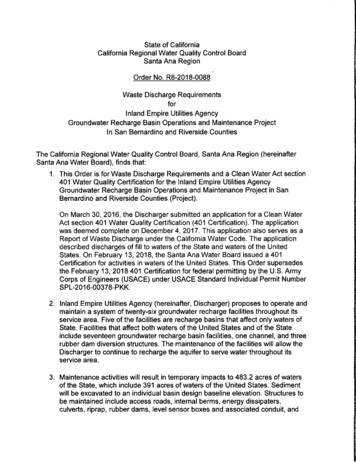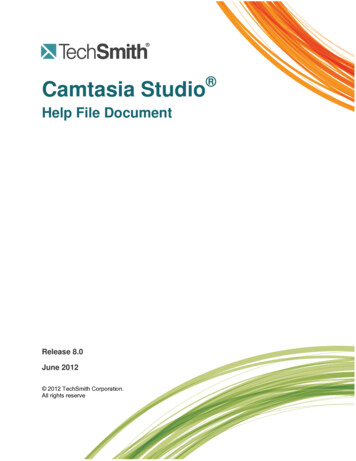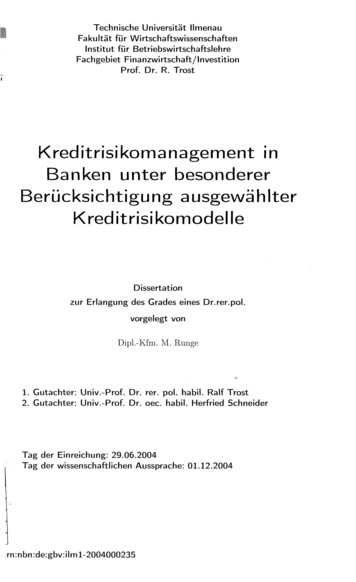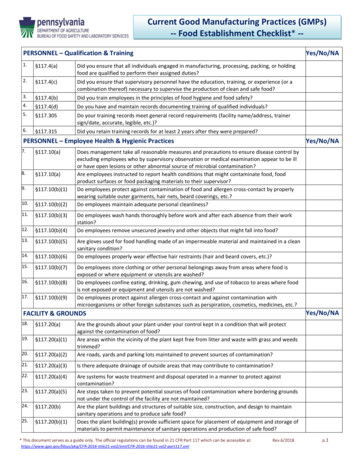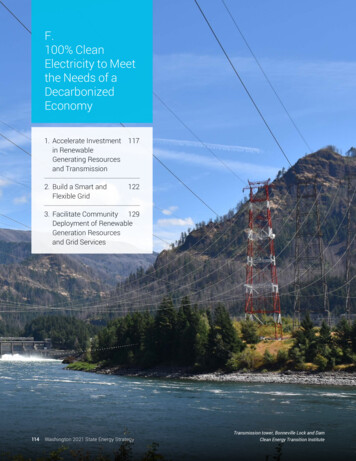
Transcription
F.100% CleanElectricity to Meetthe Needs of aDecarbonizedEconomy1. Accelerate Investment 117in RenewableGenerating Resourcesand Transmission2. Build a Smart andFlexible Grid1223. Facilitate Community 129Deployment of RenewableGeneration Resourcesand Grid Services114Washington 2021 State Energy StrategyTransmission tower, Bonneville Lock and DamClean Energy Transition Institute
F. 100% Clean Electricityto Meet the Needs of aDecarbonized EconomyElectricity will play a transformative role in meetingWashington’s greenhouse gas reduction limits. The statewill need to grow and manage clean, reliable electricitygeneration to meet increasing demand from buildings,industry and transportation. With its relatively clean grid,201ambitious clean electricity requirements and deep expertise in electricity, Washington is poised to be a leader inthe transition to an electrified, decarbonized economyover the coming decade.This will require a comprehensive change of the electricitysector—from the interactions of individual customers andcommunities with the grid to the generation and transmission of electricity across the West. An equitable transfor-Solar panels on roof of North Utility Building at Marymoor Park, WA.mation, as envisioned in the Clean Energy TransformationAct (CETA), will reflect community priorities for resilienceand affordability, ensure that all customers benefit fromjincreased electricity use in transportation, buildingssmart grid services and preserve reliable service.The electricity sector strategies complement thoseand industry.jrecommended for other sectors with end uses convertedsectors. The strategies will:jIncrease grid resilience and satisfy communitydemands for electricity services.202from fossil fuels to electricity where possible. This isparticularly true for the transportation and buildingsFulfill energy and capacity demands created byjAdvance an equitable clean energy economy andcreate living-wage jobs.Meet CETA’s requirements for a greenhouse gasThe deep decarbonization modeling analysis performedneutral electricity supply by 2030 and 100%for this strategy, combined with a review of existing decar-renewable or non-emitting (“clean”) electricity by 2045,bonization plans and independent analyses, point to awhile incorporating equity, reliability and resourcetransformational role for the electricity sector in a decar-adequacy principles.bonized future. Even in those scenarios with continued useof gas or liquid forms of energy, Washington needs cleanelectricity to produce those fuels.201“Washington State Electric Utility Fuel Mix Disclosure Reports: For Calendar Year 2018” (Washington State Department of Commerce, 2019), 0/04/Energy-Fuel-Mix-Disclosure-2018.pdf.202Ralph Kappelhoff et al., “Embracing the Voice of the Customer” (2019 Grid Forward Conference, October 9, 2019). Customer and community demands include enhanced energy security,health and environmental benefits, uninterruptible, high-fidelity power for data operations and the procurement of locally-sourced electricity.Washington 2021 State Energy Strategy115
The modeling suggests that electricity demand incombustion alternatives, Washington must continueWashington could grow by 13-20% over 2020 levels byto prioritize end-use efficiency, with particular empha-2030. Electricity load growth then accelerates, andsis on the buildings sector. This has been a successfulby 2050 is up to 92% above the 2020 level, as shownstrategy in the Pacific Northwest for more than 40 years.in Figure 26. By 2045, 42-50% of the energy used inAs the power system evolves, an increasingly smart gridWashington would be in the form of electricity, up fromwill allow more complex energy management, such as21% today. This growth — occurring parallel with CETAregional demand response programs and other non-wiresrequirements for carbon-neutral electricity by 2030 andsolutions, leading to the efficient use of renewable and100% non-carbon emitting by 2045 — will require diverse,non-emitting generation.new non-carbon-emitting generation resources.To transform the state’s overall energy system, theThe transformation to clean electricity will enableelectric power system requires substantial alteration.and require Washington to use energy more efficiently.New or expanded transmission capacity is required forIn addition to the inherent efficiency advantages ofaccess to the best renewable resources and to take fullelectric vehicles and electric heat pumps over directadvantage of coordination opportunities across the West.FIGURE 26. POTENTIAL FUTURE ENERGY MIX IN DEEP DECARBONIZATION MODELINGGrowing reliance on cleanimports to meet load growth,CETA, and emissions goalsGeneration (TWh)ReferenceImports provide 43% ofelectricity in Electrification Case by 2050ElectrificationTransport FuelsDoubling of 2020 load by2050, including new flexibleloads (electrolysis, boilers)Gas in BuildingsGrowth in clean electricityin Constrained Resourcescase due to offshore windBehavior ChangeConstrainedResources200150100500Load (TWh)2001501005002020 2030 2040 20502020 2030 2040 20502020 2030 2040 20502020 2030 2040 20502020 2030 2040 20502020 2030 2040 2050NewIndustrialNetLoadsNew IndustrialLoadsTXNet TXBulk LoadBulk LoadClean EnergyOtherClean LoadEnergyFossilSource: Appendix A – Deep Decarbonization Pathways Modeling Report, December 11, 2020 (p. 38).116Washington 2021 State Energy StrategyOther LoadFossil
A modernized grid will allow more flexibility in operationsand more use of distributed resources such as solar,storage and demand response. The institutions andorganizations that operate, plan and regulate the electricsystem also require change.1. Accelerate Investment in RenewableGenerating Resources and TransmissionSignificant quantities of new clean generation will berequired to meet the future energy requirements of Washington’s businesses and households. The resource requirements include new power generation facilities, expandedtransmission capacity, demand response resources, enduse energy efficiency and modernization of the electricdistribution grid. Washington’s utilities can choose amongmultiple types of clean generation resources.The deep decarbonization modeling suggests that windWind turbines, Goldendale, WA. Clean Energy Transition Instituteand solar will be the most cost-effective resources, but allresource decisions are subject to more specific analysis,including the 2021 Northwest Power Plan203 and individual utility integrated resource plans. Under CETA, nucleargeneration can compete as well. There also are choices tobe made about the location of new generating resources,either within the state or at more distant locations withbetter energy characteristics but greater transmissionrequirements. The actual outcome will almost certainly beand at this pace will be an unfamiliar challenge for utilities,project developers, planning organizations, the financialcommunity, regulators and siting agencies. The Legislature anticipated this challenge in CETA with additionalplanning requirements205 and authority for the Utilitiesand Transportation Commission (UTC) to use alternativeregulatory approaches.206a combination of resource types sited both in-state andRecommended approaches to meet this challenge focusoutside Washington.on a more robust transmission system across the West-The electric power system investments required bythe transformation can provide an important economicand financial opportunity for workers and businesses.However, after almost 30 years of stable electricitydemand,204 electric resource acquisition of this scale203ern Interconnection, an increased focus on resourceadequacy, reform of wholesale electric markets, improveddata and research about resource options and acceleratedmodernization of the communications and control abilitiesin the distribution system.“The 2021 Northwest Power Plan,” accessed November 1, 2020, n.204The state’s electricity consumption in 1992 exceeded its consumption in 2018, the most recent year for which data is available. “Table CT3. Total End-Use Energy Consumption Estimates,1960-2018, Washington,” Washington - SEDS - U.S. Energy Information Administration (EIA), n.d., https://www.eia.gov/state/seds/data.php?incfile /state/seds/sep use/tx/use tx WA.html&sid WA.205Chapter 19.280.030 RCW.206Chapter 80.28.401 RCW; Chapter 80.04.250 RCW.Washington 2021 State Energy Strategy117
Panoramic view of solar panels.1.1. Assess the Potential for and Facilitate Deploymentof New Clean Energy ResourcesAn assessment should engage a range of stakeholdersTo take best advantage of opportunities to develop cleanshared and incorporate public and environmental healthresources within Washington, utilities will need detailedas part of the review. Technical, environmental, legalinformation about potential locations. Accurate site infor-and economic criteria should reflect the requirements ofmation could speed resource development, avoid dupli-communities, utilities and project developers. This stake-cation of efforts and reduce conflicts among competingholder engagement should inform a statewide effort touses, including wildlife and military uses.identify clean energy corridors or development zones.In 2020, the Legislature funded a pilot study, modeledon work in California,207 to identify solar sites in theColumbia Basin that minimize conflict among potentialuses. However, this funding was among the budget itemsvetoed due to budget shortfalls related to the COVID-19pandemic.208 This pilot study concept should be expandedto a statewide assessment.and communities, ensure burdens and benefits areA successful assessment could support changes topermitting requirements.ACTIONjFunding should be made available to Commerceand electric utilities to conduct a statewide cleanenergy potential assessment to identify clean energydevelopment zones.207“Mapping Lands to Avoid Conflict for Solar PV in the San Joaquin Valley,” May 2016, h/climate/solar-pv-in-the-sjv/.208“Engrossed Substitute Senate Bill 6168,” § 604(33) (2020), 68-S.SL.pdf.118Washington 2021 State Energy Strategy
1.2. Strengthen the Transmission System across theWest and within the StateBPA and various retail electric utilities, are in the bestA power system that relies primarily on renewablein establishing NorthernGrid, a collaborative transmissionresources will require a more robust and flexible transmis-planning entity.211sion network, compared to a power system that relies onfossil fuels. Enhanced transmission capacity improvesaccess to superior wind resources in the Mountain Westand superior solar resources in the Southwest. A robusttransmission system increases reliability and reduces theamount of resources each utility must hold in reserve toposition to advance this work and build on recent progressAn important element of this work in Washington is thetransmission corridors workgroup created by the Legislature as part of CETA.212 The primary focus of this workgroup is to ensure adequate transmission capacity andappropriate environmental review of transmission proj-ensure adequate supplies.ects within the state. In addition to new capacity, addi-While unsuccessful past efforts could discourage a strat-system through the reform of transmission pricing andegy that relies on out-of-state resources and coordinatedcontract structures.tional capacity could be made available within the existingoperations, the crucial role of transmission, as well aseffective market coordination, is demonstrated in recentanalysis for the Western Interstate Energy Board.209TheACTIONSjanalysis concluded that increased regional grid integra-The Governor’s office, the UTC and Commerce shouldpursue opportunities for enhanced transmissiontion and market coordination would lower future electricityplanning and integration across the Western grid andcosts and significantly reduce the potential for curtailmentadvocate for joint development where feasible.of renewable generation.jUtilities and planning agencies should evaluate the needUnder baseline business-as-usual assumptions, renew-for joint development of new and upgraded transmis-able curtailments could approach 20% of total renewablesion capacity and consider the viability of a regionalenergy production by 2035. (Curtailment occurs whentransmission organization.renewable generation exceeds demand for electricity.)With regional coordination, curtailments would be lessthan 10% and production costs would be 2.2 billion lowerthan in the baseline case. In contrast, limited regionalcoordination — that is, no day-ahead market — results inthe highest increase in costs ( 11.3 billion in 2035) and1.3. Encourage and Monitor Development of a ResourceAdequacy ProgramOne of the core requirements of CETA is reliable service.Each utility must ensure it maintains enough resourcesleads to renewable curtailment of 50%.to maintain reliable service under a wide range of operat-The needed expansion of transmission capacity willis demonstrated by CETA’s provision allowing a utility torequire coordination among utilities, planning agen-temporarily suspend the clean energy transition if neces-cies and governments. Some stakeholders advocate forsary to preserve reliability.214 Commerce is directed to leadcreation of a regional transmission organization toan evaluation of the impact of CETA’s requirements onadminister the transmission grid on a regional basis.210system reliability and other values starting in 2023.215ing conditions.213 The priority of resource adequacy (RA)The owners of existing transmission resources, such as209Energy Strategies, “Western Flexibility Assessment” (Western Interstate Energy Board, 2019). ment-Final-Report.pdf210“Electric Power Markets,” Federal Energy Regulatory Commission, accessed November 30, 2020, � accessed November 30, 2020, https://www.northerngrid.net/.212Chapter 19.405.150 RCW.213Chapter 19.280.030 RCW.214Chapter 19.405.090 RCW.215Chapter 19.405.080 RCW.Washington 2021 State Energy Strategy119
ACTIONSjWashington utilities, resource owners and developersand other stakeholders should continue to engage indevelopment of a consistent and non-discriminatory RAprogram through the NWPP.jCommerce and the UTC should review the progress andoutcomes of the NWPP RA initiative and evaluate theneed for additional state action to ensure CETA’s RArequirements are fulfilled.1.4. Reform and Expand Wholesale Electricity MarketsWholesale markets are important for maintaining a reliableand affordable electricity supply. Invisible but beneficial toHydroelectric power plant and transmission atthe Grand Coulee Dam, WA.individual customers, these markets help utilities balancethe supply and demand for electricity. When utilities finda cheaper power source outside their own portfolio, aIn 2019, the Northwest Power Pool (NWPP), composedmarket transaction avoids the excess costs of building orof major generating utilities serving the Northwestern U.S.,separately procuring additional resources. Without elec-British Columbia and Alberta, started a project to addresstricity markets, electricity would be more expensive andRA. NWPP has proposed a program in which individualless reliable.utilities would adopt consistent standards for the amountand type of resources needed to serve customers reliably.An RA standard and program not only reduce the riskof a shortage of electricity supply, but also lower theamount of resources needed to achieve any particularlevel of reliability.While the NWPP initiative is a promising start, ongoingmonitoring and evaluation by the UTC and Commercewill be required. The effective implementation of an RAprogram in compliance with CETA will require complexanalysis of resource requirements and the contributionsto reliability from diverse resources, such as hydro, wind,solar, storage and demand response.216 The analyticalmethods must be consistent and transparent. They mustaccount for the diverse capabilities of these resourcesto ensure that renewables, storage and hybrid resourcescompete on an equal footing with thermal resources.Historically, Washington’s electric utilities have reliedheavily on a bilateral market in which individual utilities,power plant operators and brokers contract for powerat the mid-Columbia delivery point on the transmissionsystem.217 A bilateral market focuses on short-term tradeswithout a central entity to consider other financially feasible trades.Since 2014, the region’s utilities have increasingly reliedon the Western Energy Imbalance Market (EIM) to identifyand capture cost-minimizing power trades in a centralizedsystem. The EIM was created by the California Independent System Operator and PacifiCorp. By 2022, most utilities serving Washington customers will participate directlyor indirectly in the EIM.218 These markets have saved utilitycustomers in the West more than a billion dollars whencompared with the cost for each utility running its ownpower plants to serve its own customers every hour.219216“Redesigning Capacity Markets: Innovation Landscape Brief” (International Renewable Energy Agency, 2019), e Electricity and Natural Gas Market Data,” accessed November 1, 2020, estern EIM Factsheet” (California ISO, 2020), tSheet.pdf.219“ISO Announces the Western EIM Surpassed 1 Billion in Benefits” (California ISO, Western Energy Imbalance Market, 2020), hington 2021 State Energy Strategy
There is value in extending the scope of organized marketspurchases to serve retail customers. Commerce and theto cover more than the short-term market. However, theUTC are required to adopt rules by June 2022.existing wholesale electricity markets require reform toensure that market rules do not force utilities to choosebetween meeting their clean electricity obligations andrealizing the efficiency benefits of organized markets.This potential conflict arises because existing marketstypically do not differentiate between electricity fromrenewable sources and electricity from natural gas orcoal-fired plants. While market traders have the option tospecify that electricity will be renewable, the vast majorityof current market transactions are for “unspecified electricity.” This market rule is the result of industry practicerather than any legal requirement.Because of the potential conflict between market practices and clean electricity requirements, in November 2019Commerce and the UTC convened a carbon and electricity markets workgroup under CETA. The workgroupwill provide input into rules to address the use of marketElectricity market reform is necessarily a multi-state effort.Success will likely require a different organization or governance structure than the EIM, which is controlled by theState of California with participation by a Body of StateRegulators.220 For example, public power utilities in theNorthwest have published a set of principles for appropriate governance of an expanded market.221These principles include establishing a board with a selection process that is durable and independent from marketparticipants or regional governments; giving that boarddecision-making authority over market rules; engaging anindependent market expert; including a third-party disputeresolution process and ensuring that participation is voluntary. In the longer term, the industry should explore the useof market mechanisms to buy and sell capacity resources,which will become increasingly important as coal andnatural gas generating facilities are retired.220“Western EIM - EIM Body of State Regulators,” accessed November 1, 2020, yofStateRegulators.aspx.221“Northwest Public Power EDAM Governance Interests” (Public Generating Pool, Public Power Council, PNGC Power, Northwest Requirements Utilities, 2019), s.pdf.Solar installation at the Capitol in Olympia, WA. Department of CommerceWashington 2021 State Energy Strategy121
ACTIONSjWholesale market participants should develop marketrules to allow trade in electricity from sources verifiedto comply with CETA’s clean energy requirements.The UTC and Commerce, with input from the Carbonand Electricity Markets Workgroup, should adopt rulesjbut not break. Flexibility gives the system the capacity tomanage and balance variable load from both centralizedand especially distributed energy resources (DERs), likewind and solar. There is a wide range of DER technologiesand applications available today.222, 223to ensure this outcome.Developing a modern grid will require new planningElectric utilities should pursue the long-termprocesses, infrastructure, software solutions and otherdevelopment of a fully integrated Western regionalelectricity market, beginning with expansion of organized markets to trade day-ahead and longer termresources. Long-term market development shouldexplore opportunities to trade capacity resources,including demand response resources.jphysical attacks. Simply put, how much can the grid bend,Commerce’s 2024 CETA evaluation under RCW19.405.080 should include an assessment of industrytools to enable a mix of DER technologies.224 Grid operators will need new controls to securely and reliabilityoperate that future grid—managing variable demand andsupply, ensuring adequate resource capacity and providing resilience.225 Utilities will need situational awareness ofcapacity constraints and resilience for critical infrastructure to avoid issues experienced by some states with highpenetrations of renewables, such as Hawaii and California.progress in developing efficient and resource-specifiedSupported by new markets for firm capacity and otherelectricity markets.essential grid services,226 the deployment of flexiblecapacity through demand response programs and other2. Building a Smart and Flexible GridA smart, flexible and optimized grid is foundational tomeeting CETA goals and electrifying the economy whileassuring system reliability and resilience at both thedistribution and transmission levels. A modern system“non-wires” strategies, such as microgrids, will reduce gridcongestion and improve efficiency, especially at the transmission level. At the distribution level, these adjustmentswill enable interactive customer engagement and allowfor deployment of community-scale resources.allows for two-way energy flows, control and managementof the entire grid using data and digital technologies.To electrify the economy while assuringThe grid must be both resilient and flexible.system reliability and resilience requires aResiliency includes the mitigation of and recovery fromsmart, flexible and optimized grid.outages due to a range of possible scenarios including earthquakes, wildfires and human-caused cyber and222Tanuj Deora, Lisa Frantzis, and James Mandel, “Distributed Energy Resources 101: Required Reading for a Modern Grid,” Advanced Energy Perspectives, 2017, 101-required-reading-for-a-modern-grid.223“The Many Types of Distributed Energy Resources, Common and Obscure,” August 14, 2019, lsey A Horowitz et al., “An Overview of Distributed Energy Resource (DER) Interconnection: Current Practices and Emerging Solutions” (National Renewable Energy Laboratory, April 11,2019), https://doi.org/10.2172/1508510.225Appendix H – WA State Energy Strategy PNNL Presentation to CETI October 2020226These include frequency response, regulating, contingency and ramping reserves, voltage management and power quality. “Connected Communities, Funding Opportunity Announcement(FOA) Number: DE-FOA-0002206, Appendix J” (Department of Energy, Office of Energy Efficiency and Renewable Energy, 2020), n 2021 State Energy Strategy
Portland General Electric's Salem Smart Power Center includes alarge-scale energy storage system. Portland General ElectricWashington 2021 State Energy Strategy123
2.1. Expand the State’s Energy Infrastructure Security &Emergency Management CapabilitiesAs transportation and buildings are electrified and “smart”appliances become more ubiquitous, a flexible grid isessential. Flexibility will help to meet variable energy anddemand needs (e.g., the timing of vehicle charging) and todeploy distributed stored energy (e.g., storage in vehiclebatteries and water heaters). Strengthening and updating the electric grid with new technology can help preventoutages and permit real-time data sharing to increasesystem-wide efficiency.At the same time, grid modernization will require aFire threatening power lines running along US 97 in WashingtonState. WA State Department of Transportationfocus on cybersecurity and policies and practices to safeguard privacy. Privacy and security considerations arerelated but not synonymous. Generally, privacy is aboutA modern electric grid delivers reliable, affordable andclean electricity to consumers where and when they wantit. Grid resilience protects customers and businesses fromcontrolling who has access to personal information, andsecurity is about protecting that information from unauthorized access.230outages. Flexibility ensures that renewable and distributedAdvanced metering infrastructure (AMI) is one of the keyresources are smoothly integrated into the grid.components of a smart grid, but its progress has beenA better understanding of the value of DERs — especiallythe value of services ancillary to the grid — will help utilities and regulators understand the full impact and opportunity of these assets. A roadmap for DERs has been laidout through previous work on energy storage: The UTCdelayed by — among other factors — concerns aboutsecurity and privacy.231 Security protections, incentivesfor customer participation and opt-out provisions mayaddress these concerns and remove obstacles to fulldeployment.232conducted foundational work227 to understand regulatoryFurther, with regard to cybersecurity and resiliency, whilebarriers. Five different pilot projects, funded in part byCommerce is working with the National Association ofgrants from the state’s Clean Energy Fund (CEF)State Energy Offices (NASEO) to develop and review best228andsupported by analysis by the Pacific Northwest Nationalpractices for the security of solar installations, the overallLaboratory (PNNL), showed how storage can provide acapacity of Washington’s energy emergency managementrange of services to the grid, such as energy shifting,office is stretched thin. Washington should have a fullflexibility and improved distribution system efficiency.229Washington Office of Energy Infrastructure Security and227“Report and Policy Statement on Treatment Of Energy Storage Technologies in Integrated Resource Planning and Resource Acquisition” (Washington Utilities and TransportationCommission, 2017), https://www.utc.wa.gov/ ID 237&year 2016&docketNumber 161024.228“Federal Research Spurs Washington State to Store Energy,” Pacific Northwest National Laboratory, 2014, https://www.pnnl.gov/NEWS/release.aspx?id 1060.229Vilayanur V. Viswanathan et al., “Washington Clean Energy Fund: Energy Storage System Performance Test Plans and Data Requirements” (Pacific Northwest National Laboratory, April 17,2017), https://doi.org/10.2172/1474881.230“Creating Smart Communities: A Guide for State Policymakers” (National Conference of State Legislatures, 2020), art Communitiesv03 11 20 35545.pdf. p. 19.231Coley Girouard, “The State of Advanced Metering Infrastructure and Time-Varying Rates, in Three Maps and One Graph. The Leaders – and Laggards – May Surprise You.,” Advanced EnergyPerspectives (blog), accessed October 29, 2020, prise-you. Some stakeholders also express concern about AMI as a tool to perform remote shutoffs and enable workforce reductions.232Dockets U-180525, adoption order 7/29/2020 and Dockets U-180117, policy guidance issued on 4/10/2018.124Washington 2021 State Energy Strategy
Emergency Management modeled on the U.S.gency management offices about data uses and oppor-Department of Energy Office of Cybersecurity, Energy,tunities; review current industry standards for demandSecurity and Emergency Response (DOE CESAR).233response equipment; coordinate with key state agen-A fully-funded office would coordinate with localemergency management officials to includeassessment data in local hazard mitigation plans,support applications for FEMA resilience (BRIC) fundingand coordinate energy resilience data and efforts withother infrastructure planning groups, such as theWashington Infrastructure System Improvement Team(Sync),234 Public Works Board235 and the Infrastructurecies and other stakeholders to identify what standardsare already in place and what needs to be added; provideeducational opportunities for energy providers in cybersecurity best practices; and con
114 Washington 2021 State Energy Strategy Transmission tower, Bonneville Lock and Dam Clean Energy Transition Institute 1 A I 117 T 2 S 122 3 C 129 . Solar panels on roof of North Utility Building at Marymoor Park, WA. 116 Washingto 2021 Stat nerg Strategy The modeling suggests that electricity demand in Washington could grow by 13-20% over .
